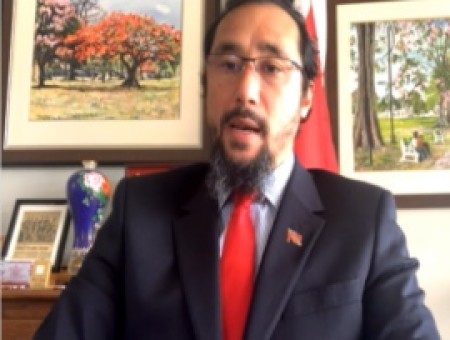PORT OF SPAIN, Trinidad –The Trinidad and Tobago government Monday said that the coronavirus (COVID-19) pandemic has had an impact on both oil and gas production here.
 Energy and Energy Industries Minister, Stuart YoungEnergy and Energy Industries Minister, Stuart Young, addressing the Trinidad and Tobago Section of the Society of Petroleum Engineers (SPETT) International Energy Resources Conference and Exhibition, said whereas oil production has rebounded to the 2019 level, gas production is taking a little longer to regain the momentum that was dampened by plant turnarounds, reduced demand due to low petrochemical prices and operational issues including infrastructure work to bring on new production.
Energy and Energy Industries Minister, Stuart YoungEnergy and Energy Industries Minister, Stuart Young, addressing the Trinidad and Tobago Section of the Society of Petroleum Engineers (SPETT) International Energy Resources Conference and Exhibition, said whereas oil production has rebounded to the 2019 level, gas production is taking a little longer to regain the momentum that was dampened by plant turnarounds, reduced demand due to low petrochemical prices and operational issues including infrastructure work to bring on new production.
“The issues that impacted on gas production in 2020 and so far in 2021 have been largely addressed or mitigated. Ammonia and Methanol prices which hovered around the US$200 per metric ton in 2020 have rebounded. As at May 2021 the US FOB price of methanol was US$375 per metric ton and the ammonia Caribbean FOB price was US$508 per metric ton,” Young said.
He told the conference that BPTT’s Cassia B Hub was shut down for just over two months in 2020 for brownfield modifications to facilitate the new Cassia C compression platform.
“The jacket has been completed and installed, the topsides and landing bridge are nearing completion in Mexico and should be on their way to Trinidad soon. Offshore hook up and commissioning is earmarked to start in the third quarter of 2021,” Young added.
He said BPTT’s Mahogany B platform was also shut down for 15 days to conduct necessary brownfield works on the Juniper platform for the tie-in of the upcoming Matapal Field development. Young said first gas from the Matapal development is projected for the second quarter calendar 2022. There was also infrastructure work undertaken by BHP to bring on stream gas from its Ruby field which was recently commissioned, ahead of schedule, in May 2021.
He said over the next 18 months, new gas production is projected to come on stream from all of the upstream operators. BHP’s Ruby project is already on stream and Touchstone’s Coho field is due to come on stream in the third quarter 2021.
Touchstone’s Cascadura and Chinook field are expected to come on line in the fourth quarter 2021. The Shell Block 5C project is due to come on stream in the third quarter calendar 2021 and its Colibri Project by second quarter 2022.
Young said BPTT’s Cassia C Compression and Matapal projects and EOG’s Osprey East are also due to come onstream before the end of 2022, adding “these projects will generate in excess of one bcf per day of natural gas production and will steadily restore gas production to the pre-COVID pandemic level.
Young told the conference that the scenarios that he has painted so far “are a snapshot of where we are with renewables and how we envisage the future of the oil and gas industry.
“Our movement to renewables is a work in progress, whereas the future of the domestic oil and gas industry is now. Therefore, we need to facilitate the maximum exploitation of our hydrocarbon resources,” he said, adding “this can be achieved by a facilitative fiscal regime and application of technology”.
Young said that he has invited proposals from industry with respect to the fiscal regime that would provide a stimulus for increased oil and gas production, adding that as a complement to this, it is incumbent on industry to employ the most advanced technologies in the exploration and development of oil and gas resources.
“The oil and gas industry, historically, has been fueled by innovation, advances in technology will play a critical role in navigating the unique challenges, ranging from commodity price fluctuations, a potential supply crunch, geo-political events, and energy policies like those relating to the energy transition.
“The employment of technologies such as subsea processing, unmanned tiebacks, well drilling and completion can result in improved safety, greater efficiency, cost savings and most importantly a reduction in the carbon footprint. The industry needs to leverage these emerging technologies so that it remains relevant and competitive during this transition period.”
Young acknowledged that the challenging COVID-impacted market environment and evolving energy sector has led to a redefining of the human resource in oil and gas.
He said technological advances such as artificial intelligence, automation and digitization, combined with advanced analytics is transforming the work environment.
“This added with the realization that the industry requires an interdisciplinary approach has raised the
issue of the consolidation of the disciplines bringing together engineers, geoscientists and other industry professionals.”
Young said that the energy sector of Trinidad and Tobago, is at crossroads and “how we navigate the transition period will determine how we fare in the new energy economy.
“Changing energy sources is not a new phenomenon. In our situation we moved from an oil-based economy to a predominantly gas-based economy. That transition was achieved through the invaluable contribution of energy professionals such as your petroleum engineers.
“Today we face a greater but not unsurmountable challenge. There is a saying that those who adapt to change survive and those who set the change lead. It is our intention to be at the forefront of change and to elicit the support of members of the SPE as we make that transition,” he added.


